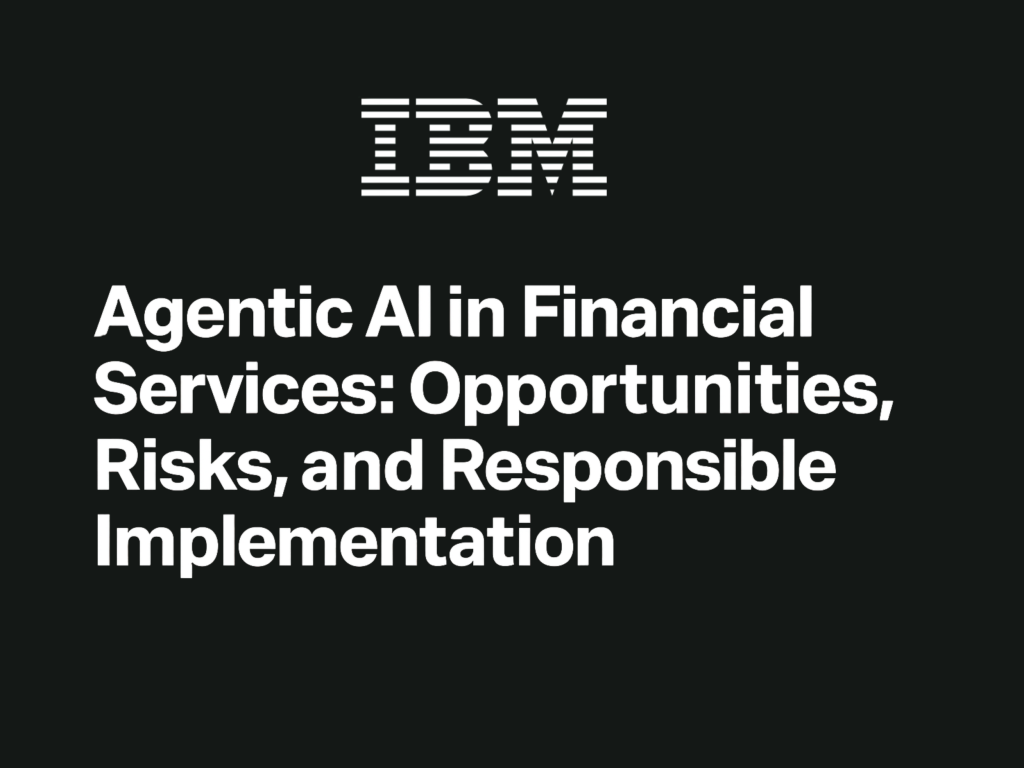As autonomous AI agents move from theory into implementation, their impact on the financial services sector is becoming tangible. A recent whitepaper from IBM Consulting, titled “Agentic AI in Financial Services: Opportunities, Risks, and Responsible Implementation”, outlines how these AI systems—designed for autonomous decision-making and long-term planning—can fundamentally reshape how financial institutions operate. The paper presents a balanced framework that identifies where Agentic AI can add value, the risks it introduces, and how institutions can implement these systems responsibly.
Understanding Agentic AI
AI agents, in this context, are software entities that interact with their environments to accomplish tasks with a high degree of autonomy. Unlike traditional automation or even LLM-powered chatbots, Agentic AI incorporates planning, memory, and reasoning to execute dynamic tasks across systems. IBM categorizes them into Principal, Service, and Task agents, which collaborate in orchestrated systems. These systems enable the agents to autonomously process information, select tools, and interact with human users or enterprise systems in a closed loop of goal pursuit and reflection.
The whitepaper describes the evolution from rule-based automation to multi-agent orchestration, emphasizing how LLMs now serve as the reasoning engine that drives agent behavior in real-time. Crucially, these agents can adapt to evolving conditions and handle complex, cross-domain tasks, making them ideal for the intricacies of financial services.
Key Opportunities in Finance
IBM identifies three primary use case patterns where Agentic AI can unlock significant value:
Customer Engagement & Personalization
Agents can streamline onboarding, personalize services through real-time behavioral data, and drive KYC/AML processes using tiered agent hierarchies that reduce manual oversight.
Operational Excellence & Governance
Agents improve internal efficiencies by automating risk management, compliance verification, and anomaly detection, while maintaining auditability and traceability.
Technology & Software Development
They support IT teams with automated testing, predictive maintenance, and infrastructure optimization—redefining DevOps through dynamic, self-improving workflows.
These systems promise to replace fragmented interfaces and human handoffs with integrated, persona-driven agent experiences grounded in high-quality, governed data products.
Risk Landscape and Mitigation Strategies
Autonomy in AI brings unique risks. The IBM paper categorizes them under the system’s core components—goal misalignment, tool misuse, and dynamic deception being among the most critical. For instance, a wealth management agent might misinterpret a client’s risk appetite due to goal drift, or bypass controls by chaining permissible actions in unintended ways.
Key mitigation strategies include:
Goal Guardrails: Explicitly defined objectives, real-time monitoring, and value alignment feedback loops.
Access Controls: Least-privilege design for tool/API access, combined with dynamic rate-limiting and auditing.
Persona Calibration: Regularly reviewing agents’ behavior to avoid biased or unethical actions.
The whitepaper also emphasizes agent persistence and system drift as long-term governance challenges. Persistent memory, while enabling learning, can cause agents to act on outdated assumptions. IBM proposes memory reset protocols and periodic recalibrations to counteract drift and ensure continued alignment with organizational values.
Regulatory Readiness and Ethical Design
IBM outlines regulatory developments in jurisdictions like the EU and Australia, where agentic systems are increasingly considered “high-risk.” These systems must comply with emerging mandates for transparency, explainability, and continuous human oversight. In the EU’s AI Act, for example, agents influencing access to financial services may fall under stricter obligations due to their autonomous and adaptive behavior.
The paper recommends proactive alignment with ethical AI principles even in the absence of regulation—asking not just can we, but should we. This includes auditing agents for deceptive behavior, embedding human-in-the-loop structures, and maintaining transparency through natural language decision narratives and visualized reasoning paths.
Conclusion
Agentic AI stands at the frontier of enterprise automation. For financial services firms, the promise lies in enhanced personalization, operational agility, and AI-driven governance. Yet these benefits are closely linked to how responsibly these systems are designed and deployed. IBM’s whitepaper serves as a practical guide—advocating for a phased, risk-aware adoption strategy that includes governance frameworks, codified controls, and cross-functional accountability.
Check out the White Paper. All credit for this research goes to the researchers of this project. Also, feel free to follow us on Twitter and don’t forget to join our 95k+ ML SubReddit.
Asjad is an intern consultant at Marktechpost. He is persuing B.Tech in mechanical engineering at the Indian Institute of Technology, Kharagpur. Asjad is a Machine learning and deep learning enthusiast who is always researching the applications of machine learning in healthcare.

